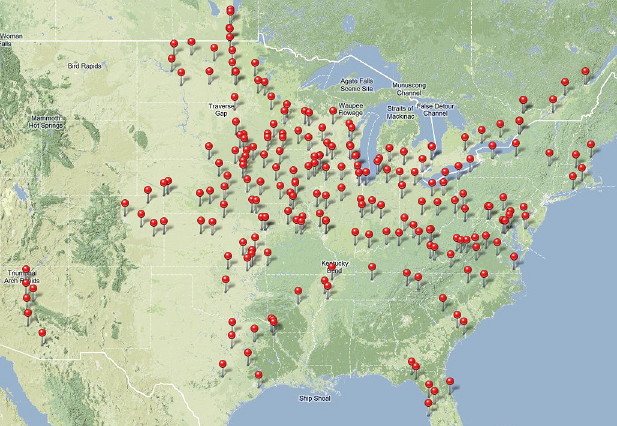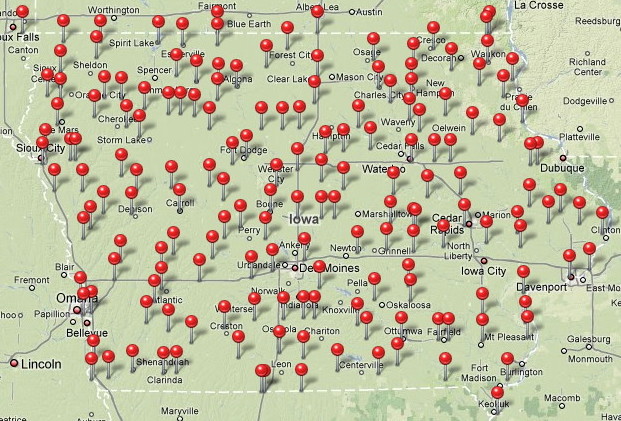Apple said, We upped our photo-management system…now up yours!
[This is a rant that needed to be written seven months ago, when the event actually happened, but nothing would have changed if it had. I know that, you know that, and Tim Cook knows that. — Ed.]
It is one thing to introduce a new application that does something “better” and expect (or demand) users to adopt it. But to introduce a new application and cripple an existing one is underhanded, arrogant, and one of the most disturbing trends in software today.
I speak of the tool I have used extensively for years and has been an integral part of the work for this website, iPhoto and specifically its Places tool. To make this clear from the outset: I use iPhoto strictly as an organizational tool. I do my work in GraphicConverter, the venerated Swiss Army Knife of image utilities. But now, the ability to pin photo locations on a map has been taken from me.
The introduction of Places in iPhoto ’09 was itself a compelling reason to get a new computer. At the time, I had 13,500 photos dating back to June 2001. I had keywords created for the counties I had the most photos in, but I had also taken trips to Virginia and in Florida in the previous 18 months. I could now pinpoint where I was when I took each photo and not only have a big map to show for it, but effortlessly call up every photo I had ever taken near a given location. After two months of work, the national map looked like this:

And the state of Iowa looked like this — keep in mind that the macro zoom levels are only representations of pin placements because of spacing issues:

Through the years, I would add locations and also copy and paste previous ones, offering me an instant glance at what I had taken in or near that place before. I could type city/county text strings in the search box, doing my best to control for false positives. For example, typing des polk gets me the city of Des Moines but not anything in Des Moines County. The tagging system created metadata searchable in the Finder, e.g. typing “Manchester” in Spotlight would have this photo included as a result:

The signs of trouble appeared slowly and were able to be ignored. Apple and Google got into an increasingly heated business war over mobile phones and Apple introduced its own mapping software. Apple Maps was universally ridiculed, but made strides, and when iPhoto 9.5 came out in fall 2013 it used that instead of Google — and also had higher Mac OS requirements. Apple was still very understanding about geotagging:
Places in iPhoto allows you to search and sort photos by location, using data from any GPS-enabled camera or iPhone. Don’t have a GPS-enabled camera or iPhone? You can still use Places by adding your own location information: Just start typing and iPhoto instantly gives you a list of locations to choose from — including points of interest like the Eiffel Tower or the Empire State Building. iPhoto also uses reverse geocoding to convert a photo’s location data, such as its latitude and longitude coordinates, to friendly place names.
The reverse-geocoding may have translated just fine to Apple Maps, but the Google Maps version in iPhoto had, for some reason, gone bonkers. Place-name typing no longer worked. Clicking to zoom in and out of a map, and then dragging the map before or after dropping the pin, resulted in the map resetting to the starting position. Placing a single photo in a new location could take minutes instead of seconds. It was a common issue. Sometime near the end of 2014 or beginning of 2015, the problem seemed to have resolved itself, and I took advantage, placing every photo I had taken before May.
Then at the beginning of July, everything went blank. Literally. I clicked on the information button, then the Places map overall, and there was nothing but a light beige expanse. (This was better than iPhoto 9.4.3 on Mac OS 10.8.5, which outright crashed.) Throughout the month, confused and frustrated iPhoto users went to the only place they could find out they weren’t the only ones suffering, the Apple discussion forums. There was no word from Apple that anything had happened, most likely because as far as Apple was concerned, iPhoto ’09 had been application-non-grata for four years and the version of iPhoto ’11 with Google Maps had been obsolete for 20 months.
And yet…the maps do exist…somewhere.

The location only appears for the first photo you check after opening the iPhoto application, and only appears for a split second — that’s why the screenshot is in mid-render. As soon as you recognize its existence, it’s gone and you’re left with a big blank space. No other photo will even get that far (until after restarting the application).
What happened? Apple’s venture into its own map program in 2012 came with the notice of canceling the contract it had with Google to provide map services. Google Maps has changed its structure since 2009 and at least one bulletin board user says it’s really Google’s fault that Places doesn’t work anymore. Apple is complicit in letting it go away, though, depriving users without notice of a tool they expected to be available. I guess users should assume anything requiring Internet access comes with an implicit arbitrary expiration date.
Six weeks after Places was gone, Apple finally acknowledged there was a problem — and its “solution” was to upgrade to Mac OS 10.10 and the last version of iPhoto. But for many iPhoto users, this is not possible. Saying “If you do not upgrade you will not get the benefits of a new application” is different from “If you do not upgrade (or pay!!) you will not get the full functionality of an application you are currently using” — but this happens more and more often as the Internet-based/software-as-a-service model grows.
What Apple doesn’t say in that Knowledge Base article (which, in full disclosure, I only stumbled upon while writing this, which should tell you how little this was publicized) is what happened to users who were running iPhoto when the Photos 1.0 app was released in April. The installation of Mac OS 10.10.3 included Photos, but also actively disabled iPhoto. The only version of iPhoto that works in that OS is 9.6.1, but Apple had already removed iPhoto from the App Store (which is the only way to get it). Users had to grope their way around search forums and find out that keeping iPhoto meant a cumbersome process of deletion and re-installation. Indeed, it is not possible to buy the last version of iPhoto anymore, period. There was no warning that iPhoto would “not work” and it wasn’t a case of leaving an entire class of applications behind, just the one.
The iPhoto/Photos chain of events is a confluence of three things that symbolize Apple in the post-Jobs era: Wrecking the user experience, assuming everyone has a mobile device and/or robust Internet connection, and telling old-school Mac users to either get with the program or get out of the way. MacNN did an entire series in April about Apple’s penchant for discarding applications that worked either by introducing a stripped-down version that later had functionality restored or walking away from it entirely. Among those are not only iPhoto but “the grand-daddy of Apple abandonware: AppleWorks.”
The Photos application scrambles the management system of iPhoto, defaulting to grouping by year rather than “event” (or as it used to be called, “camera roll”). The microscopic thumbnails often shown in the promo images — although these can be scaled up — have no separation and smack of “volume chucking”. It’s an application designed to take in a stream of indiscriminate snaps (and, God forbid, selfies). In another very-current-Apple move, Photos also takes control away from the user regarding storage itself:
It’s worth noting that Photos for OS X obfuscates the file system even more than iPhoto or Aperture do — once you import photos from your camera, it seems to be impossible to locate the original file in the Finder, even if you have Photos set to store the original, full-size images on your computer rather than only keep them in iCloud.
Apple wants you to store the images in its iCloud, even make that your primary repository. The last time Apple did this, it was called iTools MobileMe and when it was terminated, users were given a one-year advance warning. Next time, who knows?
I don’t trust the Cloud. An entity big enough to give you everything you want everywhere you want is indifferent enough to shut it off whenever it feels like it. The undignified death of iPhoto Places is a cautionary example.
Apple’s iCloud is a storage “solution” that promises you the world, for a fee above 5 GB, of course.* My main camera model is a decade old, but I have 30,000 pictures, and each one averages just under a megabyte. Do the math. Now do the math with a higher-resolution camera. (And then consider that I continue to store the originals outside of the iPhoto library, to avoid just the file-system issue the Verge hit on above.)
Finally, in Apple’s rush to kick iPhoto to the curb and inflict unleash Photos on the masses, it forgot to implement one thing: Photos 1.0 did not permit manual geotagging. The functionality wasn’t restored until version 1.1 in September. While it’s not uncommon for 1.0 releases to be lacking components, this sin of omission revealed (perhaps unintentionally) Apple’s present approach: Why would anybody need to manually geotag a photo when everybody takes pictures with their iPhone? and, Of course you want to edit things over the Internet and not care about where your files are actually located!
So what is a 2010s-techno-Luddite to do? Well, write an 1900-word rant for one, but then, not much but muddle along. I was aware of the risks when I decreed I would not go with “the latest and greatest” because, frankly, the latest was no longer the greatest. I’m not sure how “make a phone so thin it can’t hold a headphone jack but the battery life will still suck” and “introduce a laptop that doesn’t allow a power cord and external hard drive to be plugged in at the same time**” is sound strategy, but then, I’m not going to work in a spaceship.
My iPhoto Places workaround right now is pretty low-tech: Copy existing locations to new photos where possible (and as you can see at the top, I have a lot of stored locations) and for the rest, type “city, county, state” into the info box so searches still return results. It will be good enough, I suppose. But I’m really going to miss the maps that let me show just how far and wide I’ve gone.
